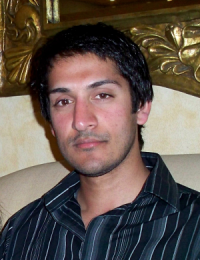
Dr Chamkaur Ghag, a postdoctoral research assistant in the Nuclear Physics Group, has won this year's Institute of Physics Astroparticle Physics Group prize.
This national early career prize is awarded on the basis of three refereed journal papers published in the last three years. It recognises his outstanding contributions to the ZEPLIN and DRIFT collaboration searches for dark matter that are taking place in the Boulby Mine, as well as other contributions to scientific research.
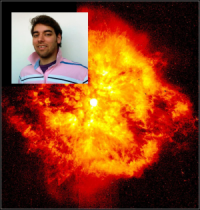
Edinburgh Nuclear Physicists working at US and European accelerators report key nuclear astrophysical reaction measurements affecting cosmic γ-ray emission line intensities, in 2 papers in same issue of prestigious Physical Review Letters journal.
Modern satellite telescopes are revealing detailed information on cosmic γ-ray emission. Distinctive γ-ray lines, associated with the radioactive decays of specific nuclear isotopes in our galaxy, are tracers that tell us that the process of production of elements, known as nucleosynthesis, is ongoing in the cosmic environment, and in our own galaxy. There remain key uncertainties as to the origins of these radio-isotopes due to orders of magnitude uncertainties in the nuclear reaction rates at the burning temperatures in stars. These reactions only take place at very low energies by quantum tunnelling, and the reactions can be ignited by the existence of single resonances located in the burning energy region known as the Gamow window.
The Edinburgh Nuclear Physics Group is internationally renowned for its work on explosive nuclear astrophysical reactions, and in particular on its links with the properties of unstable (sometimes known as exotic) nuclei. In an experimental work led by Gavin Lotay, as part of his PhD Thesis work, and Professor Woods, performed at Argonne National Laboratory, Chicago, USA the world leading Gammasphere array was used to identify key low lying resonances for the first time, thereby reducing uncertainties in the nuclear reaction rates affecting production of the cosmic γ-ray emitter 26Al by nearly a factor of a million! These results clearly demonstrate that low energy reactions on massive Wolf-Rayet stars, and the subsequent flow of material into the cosmos from stellar winds, is the most likely source of the majority of the 26Al material observed in satellite missions. This was reported in the prestigious journal Physical Review Letters [1], the image shows Gavin Lotay and a Wolf-Rayet star in the background.
In the same Physical Review Letters issue Professor Woods, Dr Aliotta, and Dr Davinson, as part of an international team reported the observation of a broad astrophysical resonance that had been predicted by nuclear theoreticians, but whose absence had been something of a mystery. This resonance was observed using accelerated radioactive beams, a vital modern approach that allows us to study for the first time key nuclear reactions that take place in the Universe in hot, dense, exploding stars such as novae, but reproduced here on the surface of the earth [2]. This result increases the destruction rate of the radioisotope 18F, in novae burning, and may explain the surprising failure of satellite missions to observe its presence through cosmic γ-ray emission.
References
- [1] G. J. Lotay, P.J. Woods et al., Physical Review Letters, 102, 162502 (2009)
- [2] J.C. Dalouzy et al., Physical Review Letters, 102, 162503 (2009).
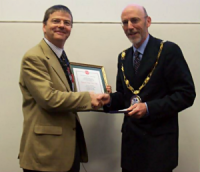
Professor Mike Cates has received the British Society of Rheology Gold Medal 'in recognition of his contribution to the theoretical rheology of complex micellar and particulate fluids'.
At the recent Annual European Rheology Conference in Cardiff, Mike Cates received the British Society of Rheology (BSR) Gold Medal 'in recognition of his contribution to the theoretical rheology of complex micellar and particulate fluids'.
The Gold Medal is the BSR's premier award: since it was founded in 1966, only 15 have been awarded. Recipients are all judged to have made outstanding fundamental contributions to rheology that have stood the test of time. Recognising the honour of hosting the European Rheology Conference, the BSR have decided to award two gold medals in 2009 ‒ one went to Mike, and the other to Tom McLeish (Leeds until recently, now at Durham).
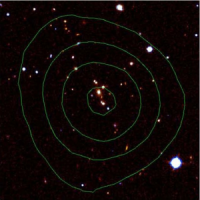
An international team of astronomers, including two members of the School of Physics and Astronomy, has found massive galaxies in existence when the Universe was barely one third of its current age. These findings, published in Nature on 2 April 2009, cast doubt on current galaxy formation theories, which predict that the stellar mass of large galaxies is built up gradually over time, whereas these observations reveal galaxies as massive as the biggest galaxies found today already in existence some nine billion years ago.
This paper comes from the team undertaking the XMM Cluster Survey (XCS) and was led by Chris Collins and John Stott of Liverpool John Moores University. It continues a decade of research by Collins and Edinburgh astronomer Bob Mann into Brightest Cluster Galaxies (BCGs) - the most massive of all galaxies, found in the cores of galaxy clusters. The XCS is finding galaxy clusters serendipitously in archival data from the European Space Agency's XMM-Newton satellite, using algorithms developed by Edinburgh researcher Michael Davidson for his PhD.
The core of the analysis is a set of near-infrared observations of the BCGs in some of the most distant known galaxy clusters, taken with the Subaru telescope in Hawaii (the image shows the core of one of the clusters, with contours of X-ray emission overlaid), followed by the careful selection of the correct model galaxies from supercomputer simulations with which to compare the properties of the observed BCGs. The comparison is complicated, but the discrepancy between the theoretical predictions and the observational data is so large – theory says that these BCGs should have reached only one fifth of their final mass by the epoch at which they are observed, while the observations imply that they already have 90% of that mass by then – that the authors can robustly conclude that current semi-analytical galaxy formation models fail to capture all the astrophysical processes which affect the formation and evolution of massive cluster galaxies.
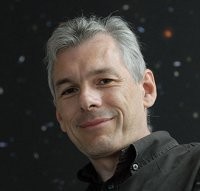
Alan Heavens, Professor of Theoretical Astrophysics in the Institute for Astronomy within the School of Physics and Astronomy is among 44 newly elected UK and International Fellows adding to the Royal Society of Edinburgh's almost 1500-strong Fellowship of experts in the Sciences, Arts, Humanities, the Professions, Industry and Commerce. Each new Fellow of the RSE is recognised within his or her peer group as having achieved excellence within their discipline or profession.
Fellows are encouraged to contribute to the aims and objectives of the Society, including the provision of expert policy advice to Government and Parliament, outreach education programmes for young people, and public engagement events including conferences and discussion forums.
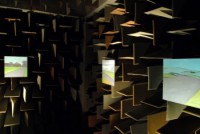
The School of Physics and Astronomy is sponsoring an innovative exhibition entitled DEAD or ALIVE at the National Physical Laboratory during Science and Engineering week
The School of Physics and Astronomy is sponsoring an innovative exhibition entitled DEAD or ALIVE at the National Physical Laboratory, Hampton Road, Teddington during Science and Engineering week. It is part of the project SOUND in a man-made environment funded at The University of Edinburgh by the Engineering and Physical Sciences Research Council under their Public Engagement programme. The exhibition is a visual and sonic exploration of sound in the environment showing works by Glasgow artist Marianne Greated in very unusual acoustic surroundings. It will be of interest to scientists and artists alike. If you wish to attend the preview on Tuesday Mar 10th 09, 17.00 – 21.00 please RSVP to Leanne O'Donnell at L.O'Donnell [at] ed.ac.uk (L.O').
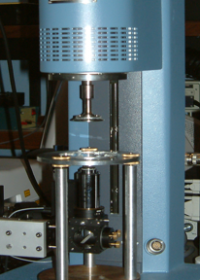
Two papers from researchers in the Condensed Matter Group have appeared in a single issue of one of the top physics journals, the Physical Review Letters.
In the first paper, Edinburgh scientists (Pierre Ballesta, Rut Besseling, Lucio Isa and Wilson Poon) collaborated with a Cretan colleague (George Petekidis) in an experimental study of the flow of concentrated suspensions in a ‘rheometer’ – a standard device for measuring the mechanical properties of many substances. The novelty here is that the Edinburgh team has built a unique instrument (see picture) to look through the sample as its properties were being determined. This led to the discovery of certain unexpected features in the way samples ‘slip’ on the walls of the measuring compartment. If such slip is not understood and properly accounted for, rheometric measurements will yield wrong results. Interestingly, the way suspensions of hard particles ‘slip’ appears totally different from the way suspensions of soft spheres do it, the latter having already been studied by Steve Meeker (who started his research career in Edinburgh) and Michel Cloitre of the ESPCI in Paris.
In a second paper in the same issue, Edinburgh scientist Richard Blythe teamed up with colleagues in Manchester (Alan McKane) and Wellington (Gareth Baxter), New Zealand to explore theoretical connections between models used to describe apparently disparate phenomena: from species diversity in ecosystems through the way opinion changes in society to the evolution of language (illustrated in the schematic diagram). The common thread is that in all these cases, particular changes eventually get ‘fixated’. Blythe and his coauthors were able to derive an approximate expression for the average time taken to reach ‘fixation’ (or, in the case of opinion, consensus). Theirs results have direct application to current theories of language change.

